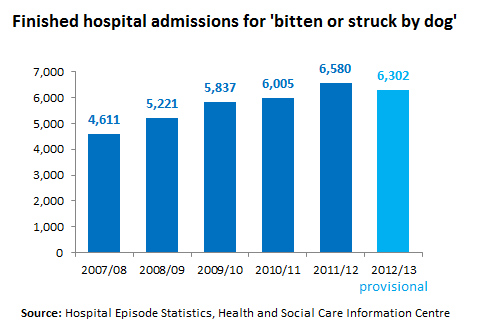Dangerous dogs: are 20,000 victims ending up in hospital?
"Dog attacks put almost 20,000 people in hospital while ministers dithered over laws to curb maulings."
Daily Mirror, 7 August 2013
The Dangerous Dogs Act has been called one of "the worst pieces of legislation ever seen", and it has made headlines again this week after the Government unveiled plans for tougher sentences for dog-owners whose pets cause harm.
Ministers have again had difficulty in keeping critics on a short leash, with today's Mirror accusing them of "dithering" while hospitals are treating 20,000 victims of dog attacks.
So is this claim accurate, or is the paper's bark worse than its bite?
While the Mirror doesn't explicitly give a source for its figure, it does provide a little more detail further down the article about what it means.
According to the paper:
"Since [the 2010 election] 18,364 people have been attacked so savagely that they had to be admitted to a hospital ward."
This figure is therefore a three-year total rather than an annual estimate of dog-related hospital admissions, and is actually some way below the 20,000 level mentioned in the headline.
Leaving these foibles aside, we can trace the numbers back to hospital admissions data collected by the NHS. While monthly data is published, the breakdowns needed to track the number of incidents related to a dog bite or strike is only available is only available in annual releases.
While this isn't a problem for our purposes when it comes to the years 2010/11 and 2011/12, data for the most recent year has yet to be published.
However the Health and Social Care Information Centre (HSCIC) has pulled together the most recent figures for a briefing given to journalists, which it has also sent to us and we've duly published. From this data we can see that over 18,000 hospital ward admissions have been linked to being bitten or struck by a dog.

While the number itself can therefore be stood up, there are a few caveats to bear in mind.
The first is that the HSCIC was keen to stress that figures for the most recent year are provisional, meaning that they won't yet have been subject to the same checks as data for previous years, and may not therefore be comparable. While they certainly seem to be in the same order of magnitude as previous years, and may therefore provide a reasonable guide to recent trends, we should be cautious about attaching such a level of precision to the figures that the Mirror does by noting "18,364" incidents.
Also, the figures represent the number of individual incidents which result in an admission to a hospital ward, and as such it isn't actually correct to say that the total represents the number of people hospitalised by dogs, as the Mirror does. Particularly negligent or unlucky dog-owners may have received several injuries over this period, and may account for a significant number of the incidents recorded in these figures, meaning that the total number of people admitted may be much lower.
Finally, we should be careful about drawing too close a link between these figures and the dangerous dogs legislation currently under the microscope. The incidents counted to produce these figures refer to when a patient is identified as having been "bitten or struck by dog" as the cause of their injury. While in many cases this might have been the result of 'dangerous' behaviour from the dog, it isn't necessarily true for all of them. We don't know, for example, how many cases might relate to frailer patients accidentally being harmed by an otherwise inoccuous dog.
So while the numbers in the Mirror's article tally with the figures available, they don't necessarily tell us much when it comes to understanding the scale of the dangerous dogs problem.